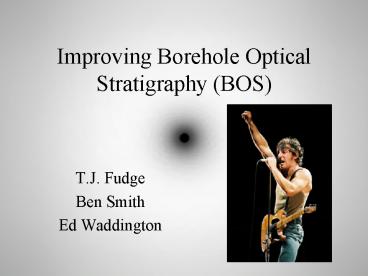Improving Borehole Optical Stratigraphy BOS - PowerPoint PPT Presentation
1 / 15
Title:
Improving Borehole Optical Stratigraphy BOS
Description:
Improving Borehole Optical Stratigraphy (BOS) T.J. Fudge. Ben Smith. Ed Waddington. What is BOS? ... BOS measures brightness of borehole wall with depth. Annual ... – PowerPoint PPT presentation
Number of Views:76
Avg rating:3.0/5.0
Title: Improving Borehole Optical Stratigraphy BOS
1
Improving Borehole Optical Stratigraphy (BOS)
- T.J. Fudge
- Ben Smith
- Ed Waddington
2
What is BOS?
BOS measures brightness of borehole wall with
depth
Hawley, 2008
3
Annual Layers are Visible
Hawley, 2005
Allows rapid determination of past accumulation
rate Ability to observe seasonal firn compaction
4
What causes the variations in brightness? Can
the physical characteristics of the firn, such as
grain size and density, be inferred from the
brightness variations?
Why is getting in situ grain size and density
important? Densification of Firn Trapping of Air
in Firn
5
Modeling the cause of brightness variations
Examine the effects of changes in grain size and
density by using a Monte-Carlo model that tracks
photons
snow grain
photon track
Firn surface
-Photons enter the firn and move by scattering.
-Keeps track of scattering events and
position photon exits firn
Scattering Length
the mean distance a photon travels between
scattering events
6
Scattering length
radius of snow grain
Density of scatters (grains)
Scattering efficiency, 2
7
Scattering length
radius of snow grain
Density of scatters (grains)
Scattering efficiency, 2
Brightness Variations can be caused by either
grain size or density changes
8
Spreading of Light due to Scattering Length Change
Fine Grain
Coarse Grain
9
Grainsize also affects albedo, but does not
dominate scattering length brightness
effects. Multiple bounces are required to get
large enough brightness changes One limitation
is that measurements cannot be made on cores
more absorption
less absorption
10
New Device Emphasis on measuring grain size
Currently designed for cores
11
New Device
Two light sources of different wavelengths
Measures spreading of light
Yellow (590nm)
Near Infrared (950nm)
12
-1
10
Modeling Results
-2
10
-3
10
-4
Intensity (arbitrary units)
10
10-4
10-5
-5
10
-1
10
950nm
-6
10-3
10
10-2
-2
-7
10
10
-8
10
590nm
0
10
20
30
40
50
60
70
80
-3
Single-scatter coalbedo
10
Scattering Lengths
-4
10
1.0
-5
10
Returned Intensity at 57.54 meters
1
2
3
4
10
10
10
10
0.8
m
geometric mean grain size,
m
0.6
Non-dimensionalized Intensity
0.4
0.2
0
6
8
10
12
14
16
18
20
22
24
26
Distance from source (mm)
13
Preliminary Results from Summit Greenland Firn
Core
Light Sources are located closest to pixel 62
14
Preliminary Results from Summit Greenland Firn
Core
Light Sources are located closest to pixel 62
Layer counting suggests annual layer thicknesses
of 17-40cm at this depth, with 3-4 years per meter
15
Conclusions
BOS brightness variations can be caused by either
changes in density or grains size. The
measurement are insufficient to determine
physical properties of the firn. A new device
using two separate wavelengths of light and
simplifying the geometry of the measurement
yields promising results for inferring grain size.































